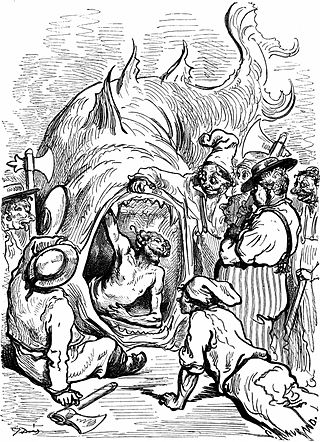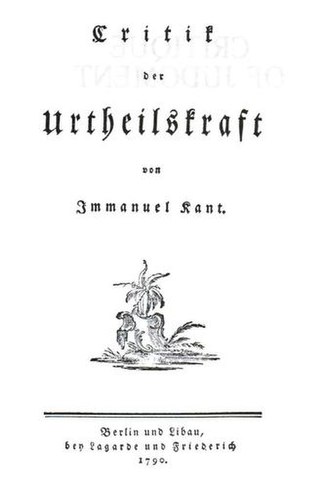Related Research Articles

The critical philosophy movement, attributed to Immanuel Kant (1724–1804), sees the primary task of philosophy as criticism rather than justification of knowledge. Criticism, for Kant, meant judging as to the possibilities of knowledge before advancing to knowledge itself. The basic task of philosophers, according to this view, is not to establish and demonstrate theories about reality, but rather to subject all theories—including those about philosophy itself—to critical review, and measure their validity by how well they withstand criticism.

Immanuel Kant was a German philosopher and one of the central Enlightenment thinkers. Born in Königsberg, Kant's comprehensive and systematic works in epistemology, metaphysics, ethics, and aesthetics have made him one of the most influential figures in modern Western philosophy.

Suspension of disbelief is the avoidance—often described as willing—of critical thinking and logic in understanding something that is unreal or impossible in reality, such as something in a work of speculative fiction, in order to believe it for the sake of enjoying its narrative. Historically, the concept originates in the Greco-Roman principles of theater, wherein the audience ignores the unreality of fiction to experience catharsis from the actions and experiences of characters.
In philosophy, a noumenon is knowledge posited as an object that exists independently of human sense. The term noumenon is generally used in contrast with, or in relation to, the term phenomenon, which refers to any object of the senses. Immanuel Kant first developed the notion of the noumenon as part of his transcendental idealism, suggesting that while we know the noumenal world to exist because human sensibility is merely receptive, it is not itself sensible and must therefore remain otherwise unknowable to us. In Kantian philosophy, the noumenon is often associated with the unknowable "thing-in-itself". However, the nature of the relationship between the two is not made explicit in Kant's work, and remains a subject of debate among Kant scholars as a result.

The Critique of Pure Reason is a book by the German philosopher Immanuel Kant, in which the author seeks to determine the limits and scope of metaphysics. Also referred to as Kant's "First Critique", it was followed by his Critique of Practical Reason (1788) and Critique of Judgment (1790). In the preface to the first edition, Kant explains that by a "critique of pure reason" he means a critique "of the faculty of reason in general, in respect of all knowledge after which it may strive independently of all experience" and that he aims to reach a decision about "the possibility or impossibility of metaphysics". The term "critique" is understood to mean a systematic analysis in this context, rather than the colloquial sense of the term.

An unreliable narrator is a narrator whose credibility is compromised. They can be found in fiction and film, and range from children to mature characters. The term was coined in 1961 by Wayne C. Booth in The Rhetoric of Fiction. While unreliable narrators are almost by definition first-person narrators, arguments have been made for the existence of unreliable second- and third-person narrators, especially within the context of film and television, and sometimes also in literature.

Transcendental idealism is a philosophical system founded by German philosopher Immanuel Kant in the 18th century. Kant's epistemological program is found throughout his Critique of Pure Reason (1781). By transcendental Kant means that his philosophical approach to knowledge transcends mere consideration of sensory evidence and requires an understanding of the mind's innate modes of processing that sensory evidence.

The Critique of Judgment, also translated as the Critique of the Power of Judgment, is a 1790 book by the German philosopher Immanuel Kant. Sometimes referred to as the "third critique", the Critique of Judgment follows the Critique of Pure Reason (1781) and the Critique of Practical Reason (1788).

The Critique of Practical Reason is the second of Immanuel Kant's three critiques, published in 1788. It follows on from Kant's first critique, the Critique of Pure Reason and deals with his moral philosophy. While Kant had already published one significant work in moral philosophy, the Groundwork of the Metaphysic of Morals (1785), the Critique of Practical Reason was intended to both cover a wider scope and place his ethical views within the larger framework of his system of critical philosophy.

In aesthetics, the sublime is the quality of greatness, whether physical, moral, intellectual, metaphysical, aesthetic, spiritual, or artistic. The term especially refers to a greatness beyond all possibility of calculation, measurement, or imitation.
In philosophy, transcendence is the basic ground concept from the word's literal meaning, of climbing or going beyond, albeit with varying connotations in its different historical and cultural stages. It includes philosophies, systems, and approaches that describe the fundamental structures of being, not as an ontology, but as the framework of emergence and validation of knowledge of being. These definitions are generally grounded in reason and empirical observation, and seek to provide a framework for understanding the world that is not reliant on religious beliefs or supernatural forces. "Transcendental" is a word derived from the scholastic, designating the extra-categorical attributes of beings.

In aesthetics, the concept of taste has been the interest of philosophers such as Plato, Hume and Kant.
This is an alphabetical index of articles about aesthetics.

In Kantian philosophy, a transcendental schema is the procedural rule by which a category or pure, non-empirical concept is associated with a sense impression. A private, subjective intuition is thereby discursively thought to be a representation of an external object. Transcendental schemata are supposedly produced by the imagination in relation to time.
A transcendental argument is a deductive philosophical argument which takes a manifest feature of experience as granted, and articulates what must be the case so that such experiences are possible. Transcendental arguments may have additional standards of justification that are more demanding than those of traditional deductive arguments.

In Immanuel Kant's philosophy, a category is a pure concept of the understanding (Verstand). A Kantian category is a characteristic of the appearance of any object in general, before it has been experienced. Following Aristotle, Kant uses the term categories to describe the "pure concepts of the understanding, which apply to objects of intuition in general a priori…" Kant further wrote about the categories: "They are concepts of an object in general, by means of which its intuition is regarded as determined with regard to one of the logical functions for judgments." The categories are the condition of the possibility of objects in general, that is, objects as such, any and all objects, not specific objects in particular. Kant enumerated twelve distinct but thematically related categories.
The following outline is provided as an overview of and topical guide to fiction:
The sublime in literature refers to use of language and description that excites the senses of the reader to a degree that exceeds the ordinary limits of that individual's capacities.
Aesthetic illusion is a type of mental absorption which describes a generally pleasurable cognitive state that is frequently triggered by various media or other artifacts. Recipients can be drawn into a represented world imaginatively, emotionally or, to some extent, rationally and experience the world, the characters and the story in a lifelike way. The emergence of aesthetic illusion depends heavily on an authored vision provided by a (media) artifact. Thus, different recipients can be expected to share similar imaginative experiences, which stands in contrast to more recipient-centered illusionist experiences like hallucinations, dreams, daydreams and delusions. Aesthetic illusion (immersion) is always counterbalanced by a rational awareness of the recipient of the difference between the "real" and the "imagined". In other words, aesthetic illusion is a double-layered phenomenon in which recipients constantly fluctuate between their "virtual" body on the level of immersion and their "real" body on the level of rational awareness and distancing effect.

Teleology is a philosophical idea where natural phenomena are explained in terms of the purpose they serve, rather than the cause by which they arise.
References
- ↑ Literary terms
- ↑ Merriam-Webster
- ↑ Kant, Immanuel (1790). 'Critique of Pure Judgement.' trans. Meredith, James Creed. Blacksburg: Virginia Tech. 91.
- ↑ Bullough, Edward (1912/1989). '"Psychical Distance" as a Factor in Art and as an Aesthetic Principle.' Dickie, G., Sclafani, R., Roblin, R. Aesthetics: A Critical Anthology. 2nd ed. New York: St. Martin's. 322.